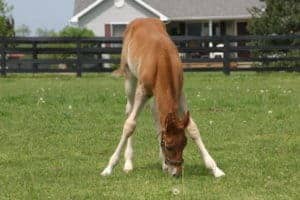
Infectious Diarrhea in Horses
Dr. Nathan Slovis shares information about the causes and diagnosis of diarrhea in foals and adult horses.

Dr. Nathan Slovis shares information about the causes and diagnosis of diarrhea in foals and adult horses.

Dr. Nathan Slovis of Haygard Equine Medical Institute in Lexington, Ky., discusses clinical signs and treatment of equine proliferative enteropathy, an intestinal disease that primarily affects foals.

Tips on properly caring for the pregnant mare, newborn foal, and growing foal up to weaning with Dr. Nathan Slovis of the Hagyard Equine Medical Institute.

Excerpted tips on properly caring for the pregnant mare, newborn foal, and growing foal up to weaning with Dr. Nathan Slovis of the Hagyard Equine Medical Institute.

Dr. Nathan Slovis describes how equine health issues will be handled during the World Equestrian Games.

Lawsonia intracellularis bacteria can cause intestinal disease in horses, pigs, and other species worldwide. The syndrome in horses is often called equine proliferative enteropathy, or EPE.
PE is caused by the obligately intracellular (can only survive in cells) bacterium Lawsonia intracellularis, which causes an unusual pathology: intracellular growth causes proliferation of the cells lining the SI), thickening the mucosa.
Potomac horse fever (PHF) is a bacterial disease that can affect horses of any age.
In today’s world, a natural or man-made disaster can strike at any time. The only defense we have is preparation. Unfortunately, many animals are dragged, stranded, drowned, or dropped during attempted rescues by untrained personnel. Rescuers often get hurt, and the animals might be more injured by the rescue than they were during the accident. Rescuing these animals shouldn’t be a rodeo. Man
Equine pharmaceutical companies are developing new drugs every year that have the ability to reduce inflammation and pain associated with various horse injuries.
Cardiopulmonary cerebral resuscitation (CPCR, previously called CPR) is the restoration of spontaneous circulation (a heart beat) with the preservation of neurologic (brain) function. The most common and immediate problem requiring CPCR is an
Equine protozoal myeloencephalitis (EPM) is a serious neurological disease and a common cause of ataxia (lack of coordinated movements) and weakness in horses. The causative agent of EPM is Sarcocystis neurona, a protozoan parasite that infects
Stay on top of the most recent Horse Health news with
© 2022 Copyright Statement dolor sit amet, consetetur sadipscing User Terms, sed diam nonumy eirmod tempor invidunt ut labore et dolore magna aliquyam erat, sed diam voluptua. At vero eos et accusam et justo duo dolores et ea rebum. Stet clita kasd gubergren, no sea takimata sanctus est Lorem ipsum dolor sit amet.